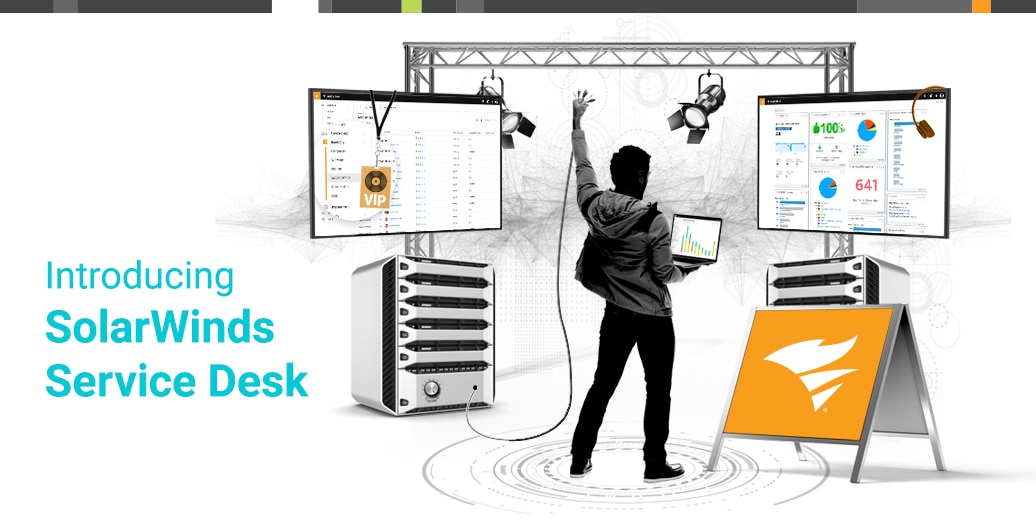The appeal of the “one stop shop” has never been greater. Amazon is taking over the world, in large part, due to the fact that customers can find anything they want within a few clicks. The consumer is accustomed to expedient options. Their travel apps reroute them around traffic. They shop for the holidays from one place -- their couches. The service portal is the one-stop shop to an ITSM solution. It connects users to all of the internal services they might need -- whether it’s the service catalog, the knowledge base, the status of their active requests or incidents, or their history of requests -- it’s all one click away.
The service portal connects users to all of the available functions of the IT service desk.
Some organizations choose not to leverage the portal. Service desk integrations still allow for communication through email. In fact, 87% of
organizations we surveyed still use email as a main support channel, and 77% still use phone support. There’s nothing inherently wrong with that, but as you’ll see throughout this article, these methods jeopardize efficiency for both users and technicians.
The service portal connects users to all of the available functions of the IT service desk. The best service portals are clean, user-friendly, and offer easy access to the status of active requests. If your organization can build a quality portal, and (equally important) drive users to submit tickets and requests through the portal, you can improve CSAT scores and resolution times, and decrease ticket volume very quickly.
Available Services in the Portal
You might be asking why the service portal is superior to traditional methods for service requests and incident management. In our two previous articles of this series, we wanted to help you visualize a successful
service catalog and a robust
knowledge base. Now, consider those two best practices in the context of traditional communication methods: If your users submit requests through email, how will they ever know what the service catalog contains? If they call the service desk with IT support issues, they’re passing over the knowledge base you’ve worked so hard to build.
The portal exists to connect them to the following pieces of functionality:
Service Catalog
Anything from expense reports, to time-off requests, to software license requests can and should travel through the service catalog. The service portal gives this menu of service items a place to live. The most effective service portals make it very easy for users to find the catalog items their looking for. You can create a list of popular services, a button to view all services by department, and a prominent search bar that connects employees to their needs.
Why is this so much better than an email request?
First off, requesters know exactly what the organization offers for services, so they can pick the appropriate one. This will make for a clean, complete request when it arrives at the service desk (more on “data collection” later). Second, it’s just faster for the requesters. No need to type up an email description with every request. Instead, requesters can click the service catalog item right from the portal, fill in some simple information, and they can rest assured it will reach the appropriate parties.
Submit an Incident
Is this an incident or a service request? Employees won’t always know the answer. That’s why the service portal allows them to submit either one. If someone needs to renew a Microsoft Office license, he/she can type “Microsoft Office license” into the search bar. If there’s a service catalog item for that, they’ll find it. If not, it’s time to submit a help ticket.
Even if a user is sure it’s an incident, submitting through the portal will give them access to the knowledge base, suggested solutions (more on this below), and a window into the status of any of their active requests.
Access the Knowledge Base
Your service desk staff is working diligently to document solutions and troubleshooting methods to incidents they work. This is where all of those resources live. The service portal should prominently display an option to browse the knowledge base for users looking for self-service options. In addition, the search function connects with the knowledge base, which can help steer users toward self-service when it’s available.
If you read our previous article on
knowledge management, you know that technicians should constantly add-to and update the knowledge base. They can comment on solutions articles or edit them. They can create new articles for new cases of incidents. With the service portal, employees will have access to all of these resources when they have troubleshooting needs.
Check Status of Tickets
One of the most common user complaints around IT support and services is that there’s no visibility into the process. Hopefully, your service desk has created versatile notifications systems around the forms of communication that the organization prefers -- be it email, Slack, instant messaging, etc. Sometimes, even that’s not enough. The service portal gives users a view of all of their active requests and tickets, allowing them to open any of them individually for full visibility.
Key Features of the Service Portal
Data Collection
There’s so much we can do with data in the modern age. In context of the service desk, ensuring complete data with every request produces two major advantages. First, it eliminates the usual back and forth upon origin of the request. Emails and phone calls often require a follow-up from a technician, then a response from the requester, where as an incident submission or service request from the portal can be constructed to collect any necessary information from the beginning. Second, complete data collection from the start allows for priority and routing automations to kick in right away for incidents. For example, maybe all incidents of a certain category go to one technician. It’s difficult for a service management solution to pull the category from a user’s email because each email is unique, but the category field can be a requirement on with a portal submission.
This might seem like just a small timesaver, but add that time up over dozens, hundreds, and thousands of tickets, and your organization will notice a significant difference.
Recommended Data Points
Next week’s article will cover more on new technology, including AI functionality and all of the things you can automate with a modern service desk solution. For now, it’s important to know that the service portal opens these doors to all employees. In our example above, correct data in the category field will allow us to automatically route tickets to the appropriate technicians. AI-powered functionality can suggest the category to users based on the history of tickets in the organization and keywords they’ve entered into the subject and body of the ticket. This helps the service desk ensure that not only are they populating the fields that will help save steps, but they’re populating the fields with correct information.
Mobile-friendly
Chances are, employees in your organization use a variety of devices. They might need to submit a request from a laptop, tablet, or smartphone. This is another reason the portal should be simple, clean, and user-friendly. Since it’s essentially offering users access to the service catalog, knowledge base, and a place to submit an incident, it shouldn’t be too complicated for a mobile phone to handle. Test your portal on any device your employees may need to access from.
Reporting
Since users won’t be in communication personally with the IT service desk as often, it’s important to include features that will report important information back to IT. This will alert the help desk early when there are networking issues, problems with the system, or important security issues going on. Decide what your help desk needs to know, and build in ways to generate those reports when customizing your self-service portal.
Service Portal Adoption
By now, you understand the advantages and possibilities of the service portal, but that’s only half the battle. Even if you create a simple, user-friendly, beautiful portal, you still need employees to use it in order to reap the benefits. How do you get them to the portal?
There are two keys to service portal adoption. First, employees need to understand the benefits to
them. Namely, the entire service catalog is at their disposal from the portal. In addition, it takes only a few clicks through the portal to see if there are self-service options for their issues, and if they need to submit a ticket, they know that the service desk will have the information it needs to resolve the issue.
When an employee calls a help desk phone line, create an on-hold message directing them to the portal for a more efficient process.
Second, the organization needs to find unique ways to push employees to the portal, ingraining it as a habit. One of the best ways to accomplish this is to leverage previous communication habits. For instance, when an employee calls a help desk phone line, create an on-hold message directing them to the portal for a more efficient process. Don’t even allow an option to leave a voicemail. As for emails, create an automated response driving them to the portal to access the organization’s history of solutions.
It’s easy to overlook this step. The value of the portal is obvious to the IT team team that leads its implementation, but they often forget to communicate its value to the employees that it was actually created to serve.
Improved Service Desk Metrics
Many organizations handle incident management through phone calls, emails, and spreadsheets. They create new tickets every time a user communicates an issue through one of these channels. Obviously, there’s no opportunity for self-service in these scenarios, so every little password reset or simple question is traveling all the way through the ticket resolution process.
When users start in the portal, they have access to all of your resources in the knowledge base. If even, say, 10% of them find a solution they can use themselves, that’s 10% fewer tickets landing on technicians’ desks.
So, if the service desk has fewer tickets, and the ones they do receive are complete with the information they need to route, prioritize, work, and solve, it stands to reason that resolution times will decrease.
See how the service portal can connect so many areas of the service desk to the entire organization? It might take an short adjustment period (and an emphasis on new habits), but requesters and technicians will quickly see the benefits. Now it’s time to bring all employees in the organization closer to internal services and watch CSAT scores skyrocket.






